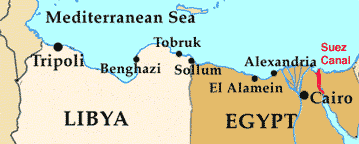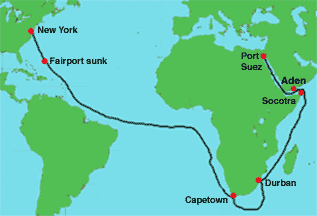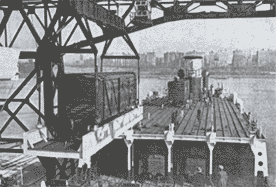Daring Voyage of SS Seatrain Texas, Code Name: Treasure Ship
During World War II, the Mediterranean coast of northern Africa was the scene of several years of see-saw battles between Italian and German armored divisions on one side, and British, Australian, South African, Free French, and Polish forces on the other. The armies continually fought over a narrow strip of coastline 40 miles wide by 1,200 miles long, which included Tobruk, Benghazi and Tripoli.
The fighting consisted of wild dashes from one supply port to another, trying to attack the enemy when he was low on the essentials of desert warfare: water, fuel, ammunition, food, and troops.
In June 1942, British forces were soundly defeated outside Gazala, Libya (east of Tobruk) by Field Marshall Erwin Rommel's Afrika Korps. The British left a garrison at Tobruk to guard their rear while they withdrew to El Alamein to lick their wounds. Tobruk surrendered to the Germans within one week. The Allies had only 70 of their original 300 tanks remaining to counter the next move of Rommel, the "Desert Fox."
After the encounter, Rommel rested his troops and awaited supplies and reinforcements. Next on his agenda was an attack on El Alamein, Egypt, beyond which were Cairo, the Suez Canal, and the MidEast oil fields.
Prime Minister Winston Churchill and President Franklin Delano Roosevelt were meeting in Washington, DC, when news of the fall of Tobruk reached them. "I did not attempt to hide from the President the shock I received," Churchill wrote later. Roosevelt immediately offered to supply America's newest tanks and anti-tank artillery for newly-appointed General Bernard Montgomery's Eighth Army.
British General Bernard Montgomery, wearing his trademark beret, at right
That same day, June 30, emergency orders went out to factories across America. Workers in tank and arms factories worked 14 to 20 hours a day for the next 9 days, to complete the order. Tanks, howitzers, tank destroyers, and ammunition were loaded on railroad trains and "highballed" to New York, where 6 ships chartered by the Army Transportation Corps waited.
The freighters Fairport, Zaandam, Exhibitor, Tarn, Empire Oriole, and Hawaiian Shipper were loaded as quickly as humanly possible in those days before containerization. The ships were loaded as the cargo arrived, without taking the time to spread the cargo equally among the six ships. The tanks, last to arrive, were all loaded aboard the SS Fairport.
Convoy AS-4, laden with nearly 85 million pounds of war materiel, sailed on July 13 from New York for the Persian Gulf with 3 destroyers as escort. On July 16, just south of Bermuda, a lone German submarine, U-161, fired 4 torpedoes at the zig-zagging convoy. Two torpedoes struck the Fairport, a C-2 on her first transatlantic voyage, causing her to sink within 10 minutes. The 43 crew, 14 Naval Armed Guard, and 66 Army passengers were rescued by USS Kearny (DD-432).
The remaining ships in the convoy proceeded towards their destination. Fortunately, there were additional newly-designed Sherman tanks available on the East coast.
Route of SS Seatrain Texas from New York to Port Suez, EgyptOn July 29, 1942, SS Seatrain Texas carrying a full load of cargo, including 250 tanks [some sources claim 300], left New York under the command of 44 year-old Captain Kenneth G. Towne on a solo journey towards Egypt. At his Navy briefing, an Admiral whispered to Towne, "Roosevelt is issuing the orders on this one himself."
SS Seatrain Texas was one of two unusual ships built in 1940 by Sun Shipbuilding & Drydock Company of Chester, Pennsylvania for Seatrain Lines of New Orleans. The Seatrain Texas, similar to two older ships in the company's service, was designed to carry railroad cars on tracks laid on three concrete decks, as well as regular cargo. At 483 feet length, with a 64 foot beam, she could carry over 8,000 tons at 16.5 knots.
SS Seatrain Texas in wartime convoy*
SS Seatrain Texas after repairs in Falmouth, England, Spring 1945*
Postwar view of railroad cars being loaded onto SS Seatrain TexasCaptain Towne did not get much sleep during the 18 days and nights it took to reach Capetown, South Africa. The radio crackled with reports of U-boat attacks along his route, and he knew the lives of thousands of Allied men rested in his hands.
At Capetown, while Seatrain Texas took on provisions, Captain Towne saw the remaining 5 ships of Convoy AS-4 in the harbor. Control over the ship's movement was turned over to the British who code-named her "Treasure Ship." On August 21, in Durban, they picked up a Free French corvette as escort through the submarine-infested Mozambique Channel. Alone again, they headed around Somalia for the Gulf of Aden.
As they approached Socotra Island [now Suqutra, Yemen] the radio operator heard a Morse-coded message, but was unable to decipher it because of severe static. Captain Towne decided to maintain radio silence, and chose not to have the message repeated.
In Aden he learned the text of the message: an Italian submarine was spotted lurking between Somalia and Socotra Island; Seatrain Texas was to change its course. It was fortunate Captain Towne did not hear the message, because the submarine did. She sank two Allied ships on the far side of the island that night.
On September 2, Seatrain Texas reached Port Taufiq at the southern end of the Suez Canal. British stevedores were on board to start the unloading process even before the ship was docked. The ship's 70 ton booms swung the tanks out of the holds onto the docks where British drivers waited.
These Sherman tanks, the first Allied tanks which matched the German Mark IV Panzer in firepower, were a decisive factor at the battle of El Alamein which began on October 23, 1942, and resulted in an Allied victory.
Sources:
The American Heritage Picture History of World War II, C. L. Sulzberger and Editors of American Heritage, American Heritage publishing Co., 1966
"Freight Cars Take to Water... Again!," Mast, June 1947
From America to United States: The History of the long-range Merchant shipbuilding Programme of the Unites States Maritime Commission (1937-1952) Part 4, L.A. Sawyer and W.H. Mitchell London: World Ship Society, 1986.
He's In the Merchant Marine Now, John Scott Douglas and Albert Salz, New York: Robert M. McBride and Co.,1943
Reader's Digest Illustrated Story of World War II, Pleasantville, New York: The Reader's Digest Association, Inc. 1969
"The Ship the Nazis Had To Get," American Legion Magazine, James H. Winchester, August, 1951
The Second World War, John Keegan, New York: Penguin Books, Inc., 1989
U.S. Army ships and Watercraft of World War II, David H. Grover, Annapolis, MD: Naval Institute Press, 1987
Maps based on: http://www.lib.utexas.edu/Libs/PCL/Map_collection/
*Photos of Seatrain Texas by Alfred DeAngelis, courtesy Ken DeAngelis
Past Features
Home3/22/01 Revised 5/6/01
www.USMM.org ©1998 - 2001. You may quote material on this web page as long as you cite American Merchant Marine at War, www.usmm.org, as the source. You may not use more than a few lines without permission. If you see substantial portions of this page on the Internet or in published material please notify usmm.org @ comcast.net




